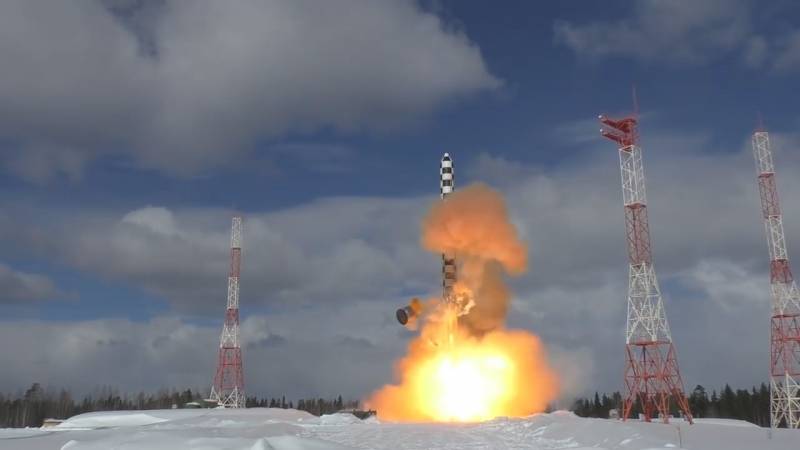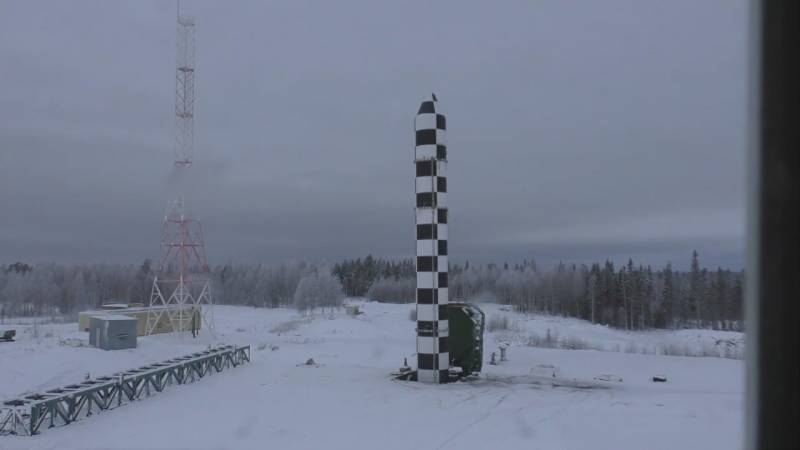PC-28 "Sarmat". Technical features and political implications
Over the past few years, the command of the strategic missile forces, as well as the military and political leadership of the country have repeatedly raised the topic of the Sarmat project and read out various information about it. As a result, it became known that in the 2021, the RVSN will receive a new complex with a heavy-class missile, characterized by the highest characteristics. Such a weapon is intended to replace the old RV-36M Voevoda and must use the same launchers.
Global weapon
It is known that the new PC-28 rocket has an improved propulsion system, which gives it the highest characteristics. In the past, the positive qualities of the Sarmat, provided by new efficient engines, have been repeatedly noted. It is the engines that can increase the combat stability and effectiveness of combat work.
Due to the greater engine thrust, the PC-28 product differs from the previous domestic-made liquid ICBMs by the reduced duration of the active flight segment. This fact in a certain way complicates the work of the enemy's missile defenses, attacking a target during acceleration, when it is most noticeable and vulnerable. In addition, this leads to the fact that during acceleration and entering the Sarmat trajectory, it remains in a safe zone, inaccessible to enemy missile defense.
New engines (perhaps in combination with certain types of combat equipment) give the rocket increased range characteristics. For example, back in 2014, Deputy Defense Minister Yury Borisov said that the new missile system had virtually no range limitations. Sarmatian combat units will be able to fly to their targets through the North or South Pole. In the future, this information was confirmed by President Vladimir Putin. According to him, in terms of firing range, the new ICBM RS-28 surpasses the existing P-36M. However, as in the past, and now accurate data on the range of flight is not available.
For some time now, the term “global weapon” has been used in reference to Sarmat. Indeed, the new propulsion system, in combination with various types of combat equipment, significantly increases the range of the missile system. Not only the territory of expected potential adversaries, but also other areas of the globe is in the area of responsibility of Russian missiles. The practical value of such weapons is obvious.
A good ball
In the course of the sensational last year’s address to the Federal Assembly, V. Putin said that the Sarmat would be able to carry a wide range of high-capacity nuclear munitions. In terms of the number and power of warheads, it will surpass the "Governor." It also provides the possibility of using promising hypersonic planning combat units - a fundamentally new combat equipment with unique characteristics and capabilities.
From the presidential statements, it follows that in the version of the carrier of the traditional split head with the units of individual guidance, the PC-28 will be able to carry at least 10 warheads. The power of each warhead is at least 800 CT. However, it is not quite clear how exactly the “Sarmat” will surpass the “Governor” in the number and power of the warheads and the composition of the fighting squadrons. Along with warheads, false targets and other means of overcoming missile defense must be present at the head. Declared the use of modern systems that provide a breakthrough through existing and promising defense complexes.
Of particular interest is the version of the PC-28 complex with the Avangard hypersonic maneuvering combat unit. So far, such products are used with the UR-100N UTTH missiles, but in the future they will be transferred to modern Sarmatians. According to known data, the Avangard product is a hypersonic glider with its own warhead, launched using ICBMs. Previously, domestic missile systems were not equipped with similar products.
According to recent statements, in flight the Avangard glider can reach speeds of up to M = 27. He carries a special warhead and is able to deliver it to the intercontinental range. Planning a flight with the ability to perform maneuvers makes it impossible to effectively intercept using existing air defense systems and missile defense. At the same time, increased accuracy of target destruction is provided.
In all likelihood, in the future, the Sarmat ICBM will take up combat duty with different combat equipment options. Nevertheless, the exact composition of the head parts and the proportions of different products in the general grouping remain unknown, and they are unlikely to be disclosed in the foreseeable future.
Safe duty
From open data it follows that the ICBM RS-28 "Sarmat" is a landmark development of its own kind. It is obvious that missiles with enhanced combat characteristics are becoming a priority target for the first strike from a likely enemy. Such risks are taken into account when developing new Russian weapons. As far as is known, in parallel with the “Sarmat”, new means are being created for the operation and protection of missiles.
In the future, missiles of the new type will be placed in existing mine launchers exempted from obsolete weapons. Such structures themselves have a high class of protection against direct impact, and in addition, must be equipped with additional means. In 2013, work was resumed on the subject of active protection complexes for silo missile complexes. In the past, such a system has confirmed its capabilities in practice, and in the future, production models of this kind will have to ensure the protection of the Sarmatians on duty.
With the implementation of all current plans, the silo complex of the Sarmat complex will become an extremely difficult target for the first strike of the enemy, capable of maintaining a high probability and providing a counter attack. In the event of a flying warhead of an ICBM or other enemy means of destruction, KAZ will be forced to knock it down at a safe distance. If the ammunition can pass through the protection system, the rocket will remain intact thanks to a solid launcher. It should be noted that the methods of passive protection of silos and ICBMs have been worked out for a long time, while the active protection complexes are new.
Threat from the future
The PC-28 Sarmat product is a serious threat to a potential adversary, but all the risks associated with it are still problems of the future. The first missiles of the new type will take over on duty in the 2021 year, and a full replacement of obsolete P-36M will take place only a few years after that. Thus, in the coming years, the existing ICBM will hold back the potential adversary.
Nevertheless, the moment of adopting “Sarmat” into service is approaching, and the industry is doing everything necessary for this. In a new message to the Federal Assembly from February 20, V. Putin mentioned the continuation of testing of the PC-28 product, but did not go into details. On the same day, the TV channel Zvezda published some data on the current successes of the project.
Last year, the success of the new missile test phase ended. In the course of these works, fifty design and test tasks were performed. It was possible to confirm the correctness of the constructive solutions used in the project. Were also conducted bench tests of engines for the rocket. Practical work on the stage of breeding.
At the same time, industry is being prepared for the mass production of missiles and objects of the Ministry of Defense for new tests. Thus, the infrastructure for flight and state tests of the Sarmat is being completed at the Plesetsk test site. The enterprises involved in the project are updating their production facilities, which in the future will allow them to participate in the assembly of an experimental batch of missiles, and then master the series.
This year, the first test launch of the new rocket is to take place at the Plesetsk test site, followed by a full-fledged flight and the defeat of a conventional target at the Kamchatka Kura test site. Flight tests should be completed in 2020-21, after which the missile complex will be adopted. Next will begin full-fledged mass production with the production of missiles on duty.
It is in 2021 that the ICBM RS-28 will begin to realize their potential and will become a new military-political tool. First, they will solve common problems together with outdated Р-36М, but then they will completely override them and fully occupy the corresponding niche. Most likely, the update of the arsenals of heavy ICBMs will not lead to a noticeable change in the quantitative indicators, and in the future there will be about the same number of Sarmats on duty as the Governor now costs. However, one should expect a noticeable increase in the qualitative character, provided by an increase in the characteristics and the obtaining of new opportunities.
Thus, by the middle of the next decade, Russia will have a new promising strategic deterrent tool with special capabilities. The threat of a reciprocal use of the Sarmat PC-28 missiles, capable of breaking through any existing missile defense and delivering accurate strikes using any combat equipment, must act soberly on excessively hot representatives of the command of a potential enemy.
On the materials of the sites:
http://mil.ru/
http://kremlin.ru/
https://tvzvezda.ru/
https://tass.ru/
https://ria.ru/
https://bmpd.livejournal.com/




Information